The chassis of the car is the part which experiences the most of the abuse from the driver. It is particularly due to the weight transfer of the vehicle body during fast cornering, hard braking or hard acceleration. In some instances, the weight transfer during cornering may cause one side of the vehicle to experience as much as 3 times more force than the other side of the vehicle, causing enormous chassis flex/ vehicle body deformity and twist, consequently causing tires to lose grip. Deformity and twisting of the vehicle chassis during cornering may cause negative handling traits such as understeering and oversteering.
CHASSIS FLEX is a bad thing for several reasons. The first reason is that we can't control it. You want cornering forces and energy to be handled by your suspension because the suspension has hopefully been setup to handle it in a very specific way in order to make the car handle well. If the chassis is flexing, we have no control over it's spring rate and it definitely is not getting any sort of damping force. Chassis Flex is uncontrolled motion and controlling motion is whole point of suspension tuning. Another drawback of Chassis Flex is that it throws off the alignment. Ruined alignment will throw off force transfers and tire contact patches. Also mitigating the amount of flex in the uni-body will reduce metal fatigue that leads to failures such as cracking and distortion.
Although some cars spend most of their lives driving in a straight line. Such cars might experience the strut towers moving together over time. Track cars spend a lot of their time cornering at over 1G. Thus a track car might see it's strut towers spread apart over the years. What this means is that a strut tower bar can be under tension OR compression depending on the environment that the car is operated in.
The installation of strut bars / Anti-Roll Bars are also essential when attempting to correct oversteering and/or understeering characteristics. As most modern cars go, car manufacturers employ the FF (Front engine, Front wheel drive) setup for improving driver and passenger safety. The natural behaviour of an FF car is to have a slight understeer, due to its heavier front end. Understeer happens when the front wheels lose their traction and won't turn any sharper, even when the steering is being corrected to turn the car more. This will cause the car to go wide instead of following the line. Understeer can be corrected by stiffening the rear end of the vehicle by adding a rear strut brace and a Rear Anti-Roll Bar.
On the otherhand, Oversteer is when the rear tire lose grip and causing the rear end of the vehicle to slide out of a corner. This phenomenon happens particularly to FR (Front engine, Rear wheel drive) or RR (Rear engine, Rear wheel drive) cars with heavier rear ends. Vehicles with In-Car Entertainment Systems that carry a heavier rear load due to the ICE setup will highly benefit from this chassis reinforcement technique. Oversteer can be corrected by stiffening the front end of the vehicle by adding Front Strut Bars and Front Anti-Roll Bars.
A strut bar can give your car a totally different feel. With a strut
bar, cornering is easier and the handling is more predictable. You have more peace of mind with the addition of a strut brace because it can also be regarded as a safety upgrade, as it allows for the forces to be evenly distributed during a collision which could reduce the extent of Injuries. Moreover, since a strut bar is designed to tighten up your chassis, the chassis
is less likely for it to get damaged or bent. Therefore, your vehicle
can last longer. Most economy cars do not come with a strut bar.
The reason for this is because manufacturers cannot justify the extra cost when competing in the budget or entry-level market. If you love a vehicle that handles well, a strut bar is a simple way
to increase the rigidity and improve the handling of your car.
Body roll (or lean) happens when you turn into a corner. As your car begins to turn, its weight is thrown to the outside of the corner, causing your car to roll in that direction. Put simply, as you turn left you are thrown to the right and turning right throws you left. Your wheels are in constant contact with the ground so always stay on the same level but your car’s body (and, by extension, the cabin in which you’re sitting) sit on top of springs attached (indirectly) to your wheels – allowing the car’s body to lean independently of the wheels.


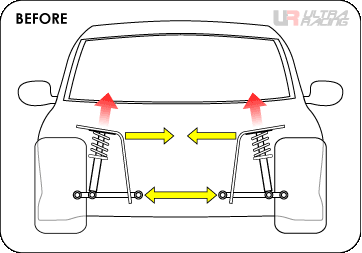

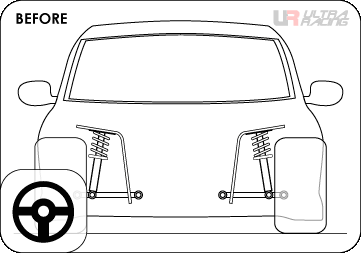
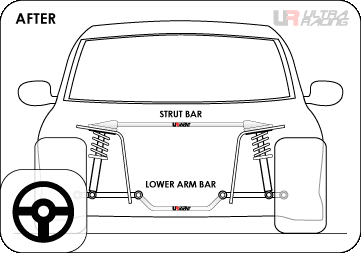
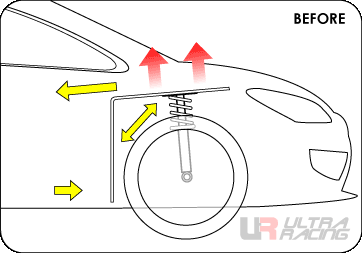
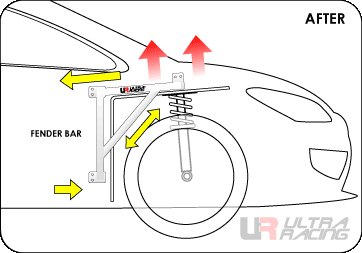
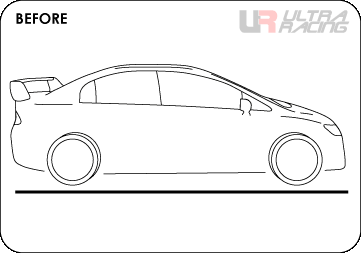

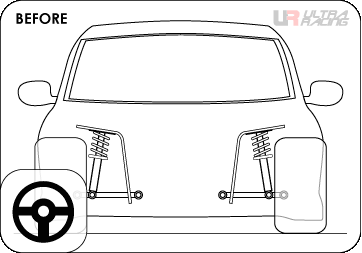
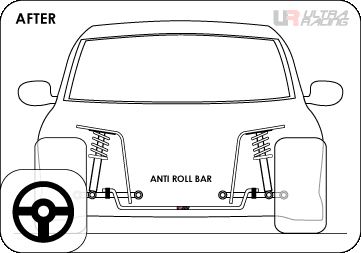
Ultra Racing’s anti roll bar will effectively reduce / prevent the extent to which a car leans while cornering and reduce body roll by up to 40% while enhancing the vehicles stability and allowing greater cornering speeds.
© Copyright Ultra Racing SA
